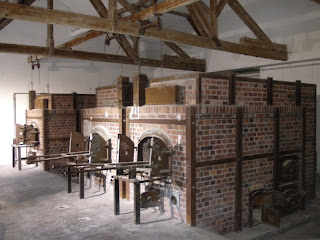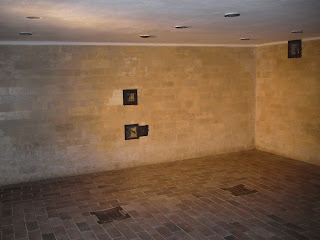Yet, it is quite important to chart the entire spectrum. While Germany holds a flourishing past, its time during World War II is one the darkest for the Motherland.
The repercussions of such a period have had a colossus effect on Germany's world reputation and its backlash can still be seen today.
With the final day in hand, we felt it imperative to ingest this important part of Germany's history and more importantly, observe how its had it's effect internally.
We met up with a small group at the Marienplatz (central Munich) for our first tour.
This tour was titled "Hitler's Munich."
Adolf Hitler's rise first began in Munich. After achieving monumental success here, he than furthered his endeavors throughout the country. But the seed was born in Munich.
The basic aim for the guide was to visit key sites in Munich and explore Hitler's climb to power through these specific locations.
Our tour guide was actually British. She's been living in Munich for 30+ years.
The tour took us to a variety of interesting places. Hitler's favorite cafe, art studio, as well as the meeting point for his first revolutionary group:
The above photo is actually from the second floor of the Hofrenbraus!
We also visited key places where important actions turned the tide to Hitler's favor. For instance, we observed a busy square deep in Munich which spurred the first trappings for revolution. In this square, three German soldiers were killed in a gang riot. Hitler used their deaths as means to showcase the lack of authority the current German government held.
There used to be a Nazi plaque below, commemorating the death of the soldiers, but it has since been removed:
We also focused on some of the subtle touches Germany has sprinkled throughout the city that observe the dark period. Interestingly enough, our guide discussed that the Germans do not remember the events in an over-the-top spectacle, but through subtle touches throughout the year that acknowledge the circumstances. Incredibly fascinating...
This monument held a flame inside a chained cubicle. It represents the inability to cage the flame of freedom.
Near the end of the tour, we stopped by two key locations.
The first was the headquarters of the Gestapo in Munich, during World War II:
Alas, it's now become a bank...
The final, was the headquarters for foreign affairs during WWII:
It was here, after Germany invaded Czechoslovakia, that Hitler along with Mussolini, Chamberlain, and Daladier conversed about the effects of Germany's actions. Mussolini, being a master of the languages was able to convince England and France to allow Germany to gain Czechoslovakia. This became known as the Munich Agreement.
When the settlement was resolved, there was a sigh of relief around the world. Having just endured World War I, nobody wanted another war. This agreement would prevent another war from taking place.
Unfortunately, Germany then invaded Poland...
The building is now a school for musical arts.
As our tour came to end, we decided to take a quick break because next tour would be beginning quite soon. This one would involve traveling to Dachau and exploring the infamous concatenation camp found in the outskirts of the town. The Dachau camp was the first concentration camp to be developed and shockingly housed up to 32,000 inmates in its final years.
Dachau is very close to Munich and only requires a 15 minute train ride to reach it.
When stepping off the train, it's almost impossible to grasp it's the nihilistic past. The atmosphere is quite pleasant and simple. It's a genuinely splendid German town. We took a bus to the outskirts of town.
We arrived outside the Concentration Camp to find a carefully designed facility for visitors. It housed a bookstore, cafeteria, bathrooms, and a whole host of utilities for visitors to use, prior to entering the Concentration Camp.
We continued past the facility and soon approached the chillingly entrance to the Dachau Concentration Camp.
While we had the luxury of traveling on bus from the train station, the prisoners were subjugated to unfortunate circumstances. As they would arrive from the train station, they were forced to walk to the camp.
Walking through the front gates and observing the expansive space was quite a shock. Just imagining the trials and tribulations that took place on these grounds was quite unearthly. It was totally quiet and very cold.
This should give you a taste of the expansive isolation:
Dachau Camp
We entered into the first barracks, which held much of the historical information.
We saw some of the instruments of torture:
As well as beams where prisoners were hanged:
Although the prisoners were living under ridiculous sub-par standards, when higher officials would come and inspect the facility, they would be forced to put on a facade.
The German officers would only show the inspectors certain parts of the Camp, along with reassurance that the prisoners were being kept in good condition. Obviously, the prisoners were sentenced to utter silence and were unable to speak against such false claims. The survivors from Dachau claimed that putting on this facade was the most painful ordeal of all. While they were being under-feed, forced to work ridiculous hours in harsh weather, and treated like animals, this false spectacle is what killed them.
We were then led into the farther reaches of the camp.
We observed the Watch Towers, along with the barbed wired that encircled the camp.
This deep ditch covered the surroundings of the camp, making it almost impossible to even reach the threatening fence.
The prisoners were forced to dig the encompassing pit, formed to keep them in. Digging they're own hole.
We arrived to a small bridge.
If the prisoners were miraculously able to make it out of the camp, a river would be waiting them on the other side.
As continued on, we were presented with two dense buildings up ahead.
As we approached the first one, we immediately understood its purpose:
With the death toll steadily increasing, the burning of the bodies was the chosen solution.
Two bodies could be placed in at each time.
Really dark stuff here, people.
The second building was much bigger.
Dachau was known as the "experimental" camp. They would construct and test out ideas here, and if successful, they would implement them in other camps.
This building was for the development of the gas-chambers.
Oddly enough, the gas-chambers built in Dachau were never used. It's not known why it wasn't put in use here.
Regardless, the construction is exactly how the gas-chambers would be developed.
We saw the compartments where the gas grenades would be thrown in.
We walked through the room where prisoners would change, thinking they were going to shower.
The following sign even reads in German, 'shower.'
Here is the actual shower, along with passages for the poisonous smoke to clear after being used:
After traveling through the depraved chambers, we escaped into the cool breeze.
And slowly trekked back to the entrance.
Just before leaving, we observed some of the memorials developed for the camp:
The experience of visiting Dachau is two-sided. While on one side, it's uncompromisingly bleak, it provides you with an incredible amount of growth. Your able to understand and experience the trials and tribulations of the this dark period without a glass separating you. Experiencing Dachau firsthand is something documentaries or film cannot provided. Subtle details sprinkled throughout, along with the chilling atmosphere is something only a visit to the camp would provide. Internally, it makes you a better person. Realizing how much the prisoners suffered makes you appreciate your surroundings and develop your future in a new light.
While not an enjoyable episode by any means, it remains an essential endeavor and something I thoroughly recommend experiencing while journeying through Germany.
A memorial that encompasses the fiery culmination of the entire ordeal is what I'll end this entry with:





































No comments:
Post a Comment